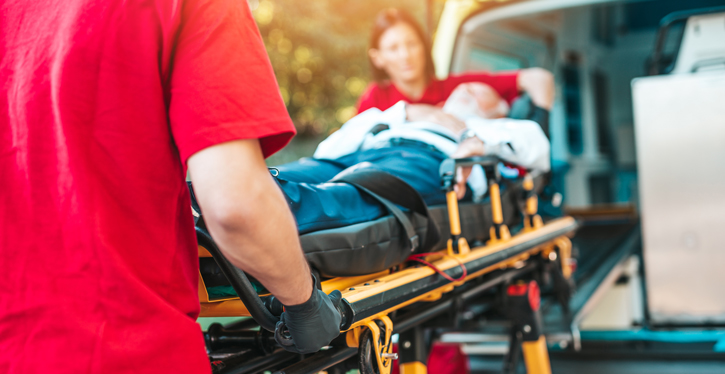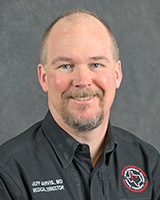May 29, 2024
With New EMS Quality Measures, Florida Aims to Have a National Impact on Rural Care

A set of new quality measures developed in Florida and endorsed by the National Emergency Medical Services Quality Alliance (NEMSQA) aims to help rural EMS agencies across the country care for their patients more effectively.
More than 40 new measures were developed through the Feasible, Actionable, Impactful and Relevant (FAIR) EMS Measurement Project, an initiative by the Florida Department of Health (DOH) that launched in 2020 and wrapped up in 2022. The goal of the FAIR Project was to improve access to quality care in Florida's rural areas, while building a national model that other states could follow, too.

In October of 2023, NEMSQA announced its endorsement of ten of those measures for national use. Going forward, Florida EMS and NEMSQA officials are hopeful that these measures will improve rural EMS care across the U.S.
Jeff Jarvis, MD, Chief Medical Officer and System Medical Director for the Metropolitan Area EMS Authority in Texas and a member of NEMSQA's leadership board, describes the new measures as a "turnkey solution" for small, rural EMS agencies around the country.
My hope is that by providing this turnkey solution to measurement, we enable quality improvement for these smaller systems who haven't been able to do it before.
"My hope is that by providing this turnkey solution to measurement, we enable quality improvement for these smaller systems who haven't been able to do it before," Jarvis said. "And that by doing that, we improve the level of care provided to our patients everywhere, but particularly in rural areas where they may have a little more constraint on their resources."
Moving past an 'archaic' approach
In Florida, a state with 30 rural counties, State EMS Director Steve McCoy had noticed a pattern of outdatedness in how the state regulated its EMS processes and care. The regulations were based on older statutes, and were largely centered around equipment — for instance, how many of a certain item were on each ambulance.
"I'm sitting back thinking about this, and thinking about how things like that don't really have anything to do with the outcome of patient care," McCoy recalled. "It's really kind of archaic."
At the same time, McCoy knew that Florida had relevant data on hand — and plenty of it. The state had collected more than a million records from rural EMS agencies over a period of time. If the state could use that rural data, McCoy thought, it could come up with new measures that more effectively addressed the quality of patient care in Florida and beyond.
It was important to me when we did this that we did it right, and that we did something that could impact the whole country.
"It was important to me when we did this that we did it right, and that we did something that could impact the whole country," McCoy said. "I mean, we could get a measurement of how well we treat an alligator bite, but how much good is that going to do in Idaho?"
In 2019, the Florida DOH received supplemental EMS funding through the Federal Office of Rural Health Policy's (FORHP) Medicare Rural Hospital Flexibility Program (Flex program) to launch the FAIR Project. Through partnerships with NEMSQA and an EMS data platform, the state used rural and urban data it had collected over the years to test potential new measures after surveying agencies across the country about their own measurement priorities and conducting a scientific literature review.
"Once we've tested a measure and it works, we put it out for a public comment, and then we put it out for another public comment," McCoy explained. "If it survives that round, then we have a good measure."
A national impact
While Florida looked to improve care in its 30 rural counties and beyond, NEMSQA leaders also saw a national opportunity to help rural agencies.

"EMS is underfunded throughout the nation, but it's particularly underfunded in rural areas," Jarvis said. "When we're talking about EMS, we're largely talking about systems: it's not just a good clinician you need, it's an entire system that has to be good. And one of the challenges in a rural area is you don't have a whole lot of money to dedicate to improving an EMS system."
McCoy sees quality measurement in rural areas as "just as important, or more important, than in urban areas" due to the unique geographic challenges that rural EMS agencies face.
"When you look at the time that a rural paramedic spends treating a patient versus the time an urban paramedic might spend, it could be two hours versus 10 minutes," McCoy said. "Rural paramedics have to have those skills and processes in place. They have to know those protocols four or five layers deep. So there's a different type of clinical aspect in rural EMS than there is in urban."
While the more than 40 measures developed through the FAIR Project have been adopted by the state of Florida, NEMSQA chose ten of the measures to endorse nationally. As part of the endorsement process, NEMSQA's steering committee ranked and prioritized each of the measures that came out of Florida as well as other publicly available national, regional, or state EMS measures.
We needed to make it manageable for the EMS community, and also manageable for our organization.
"Not only did we not want to overwhelm the EMS community with, 'Here are 40 things you should be looking at,' we didn't want to overwhelm ourselves as far as how much we can do to maintain the integrity of the measures that we put out into the EMS community," said Sheree Murphy, Executive Director for NEMSQA. "We needed to make it manageable for the EMS community, and also manageable for our organization."
'Moving the needle on improvement'
The ten NEMSQA-endorsed measures address topics including airway management, respiratory care, safety restraints, trauma, the documentation of vital signs, and clinical assessments for traumatic brain injuries (TBI).
Jarvis, who describes himself as "extraordinarily passionate about airway management," says he believes the new measures related to that topic will be particularly impactful.
"I'm really, really excited about those because I think they accurately depict what the best practice standard of care is," he said. "And this is something that no matter how often we lecture about it, we're not really moving the needle on improvement.
"What we're finding is when you give people these measures, they see how they're performing on something, and the things that they assumed they were doing well, they're not doing quite as well as they thought they were," he continued. "And now all of a sudden their mind has opened up and they're like, 'Well, that's not good. We really need to focus on this.' This allows people to focus their attention on these airway measures."
Murphy, who volunteers with a rural EMS agency, points to a measure dealing with the documentation of vital signs for non-transported patients as her personal favorite.
"We see so many calls where patients decide they're not going to be transported, and I think making sure that they get a proper evaluation to make that determination is so important," Murphy said. "When a lift assist happens twice in a week [for one patient], you have to start thinking, 'Okay, something else is probably going on here.'
"That measure is fundamental care that can apply to any diagnosis that you're going to respond to," she added. "So it makes it really applicable in rural areas where you may not have the call volume to get meaningful data on some of the more specific measures that we might look at."
To familiarize rural and urban EMS staff with the FAIR measures, the Florida DOH has incorporated the new measures into classes on airway management and other topics. In these classes, EMS workers learn about the new measures as well as how to implement them.
"The light bulb goes on with a lot of the field-level staff in rural EMS agencies once you incorporate that measurement with them," McCoy said. "They're seeing how it's being measured, and we're teaching them how to do it at the same time."
Beyond the impact of the measures themselves, McCoy hopes that the FAIR Project will serve as a national model for utilizing data to improve EMS care.
…you can collect all the data you want, but if you're not using it correctly, all that effort's for nothing.
"It's just amazing how much effort has been put into collecting data," he said. "Now we need to focus on disseminating that data. Because you can collect all the data you want, but if you're not using it correctly, all that effort's for nothing. I want to see more standardization of data dissemination and use and implementation. If we do that, I know in my heart and mind that things will improve."

